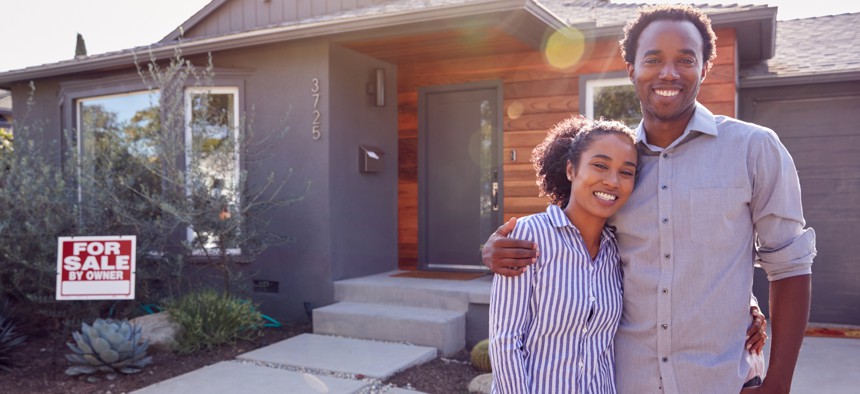A Breakdown of the Black-White Homeownership Inequality Gap

iStock.com/monkeybusinessimages
Homeownership is less achievable for Black Americans and they live in neighborhoods with houses valued at $48,000 less than white families’ homes, a new report reveals.
Homeownership is often less achievable for Black Americans and when they do own property, it's valued at less than a home owned by a white family, according to a report from the Brookings Institution.
About 46% of Black people own a home, compared with 76% of whites, Brookings says. Homes in Black neighborhoods are also valued at $48,000 less than those in predominantly white neighborhoods. This creates a cumulative loss in equity of approximately $156 billion, becoming a significant contributing factor to the racial wealth gap.
Black homeownership and the racial wealth gap are byproducts of systemic racism, including the legacies of slavery, Jim Crow segregation and other racially motivated policies that targeted Black people and their neighborhoods, according to the report.
Jim Crow laws were a collection of state and local statutes that legalized racial segregation. The laws, which existed for about 100 years from after the Civil War until 1968, were meant to marginalize African Americans by denying them the right to vote, hold jobs, get an education or have other opportunities.
In the South, officials used Jim Crow laws to raise property taxes to punish Black homeowners and churches that boycotted white businesses or hosted civil rights meetings.
White tax assessors place a heavier tax burden on Black residents by intentionally overvaluing their property, some studies show. Racially motivated or not, many tax assessors still give Black and minority residents property tax bills that are too high given the value of their homes.
Here are the other top takeaways from the report:
Segregation of Black residents persists in cities. According to the report, the largest Black populations are in Cleveland, Atlanta, Baltimore and Detroit. Apart from Cleveland, in which 48.8% of residents are Black, these cities are more than 50% Black. Detroit has the largest percentage of Black residents in the sample at 78.3%.
In Atlanta, the city with the highest levels of Black segregation in the sample, almost 70% of Black residents would have to move to another area to produce larger racial distributions.
Notably, these four cities also have the highest proportions of Black residents in the sample, reflecting the impact of historic and modern policies aimed at segregating cities, particularly those with large Black populations, the report states.
Unequal access to lending makes it harder to build lasting wealth. Racial economic inequality in the U.S. is primarily the result of unequal investments among communities, according to the report. The report also shows that 46% of Black people are unbanked or underbanked, which is over three times the percentage of whites (14%). Some 32% of Hispanics are also either unbanked or underbanked.
According to Brookings, Black communities have a prevalence of alternative financial services like money order services, check cashers and same-day lenders to manage finances. These high-cost, low-quality financial services tend to trap borrowers in cycles of debt, increasing the financial vulnerability—especially among communities of color—and blocking efforts to build lasting wealth.
The amount of underinvestment and a prevalence of alternative banking make Black people more likely to encounter discriminatory lending practices, which also impact credit scores. Without bank accounts, families often cannot generate the data that helps establish creditworthiness, the report contends.
Higher costs for education result in Black students taking on higher levels of debt. Given the lack of mainstream banking in their communities, Blacks are more likely than whites to receive unsubsidized loans for education, according to the report. Unsubsidized loans increase the amount of debt that college graduates have to take on to pursue higher education. In turn, this makes higher education less attainable for Black students, according to Brookings.
Black college graduates also experience more difficulty accumulating wealth than white college graduates because they accumulate more student loan debt. Graduates from historically Black colleges are also more likely to receive subprime loans with higher interest rates.
Of all cities studied, Detroit and Cleveland have the lowest levels of Black educational attainment (approximately 21% and 20%). Both cities are also in the bottom half of educational attainment across all racial groups.
For this analysis, Brookings used publicly available data sources including the U.S. Census Bureau’s American Community Survey and the federal system. Brookings also utilizes credit scoring data from numerous credit bureaus.
For more information from Brookings report click here.
Andre Claudio is an assistant editor at Route Fifty.
NEXT STORY: Tax or Treat! State Laws on Candy Taxation Vary Wildly





